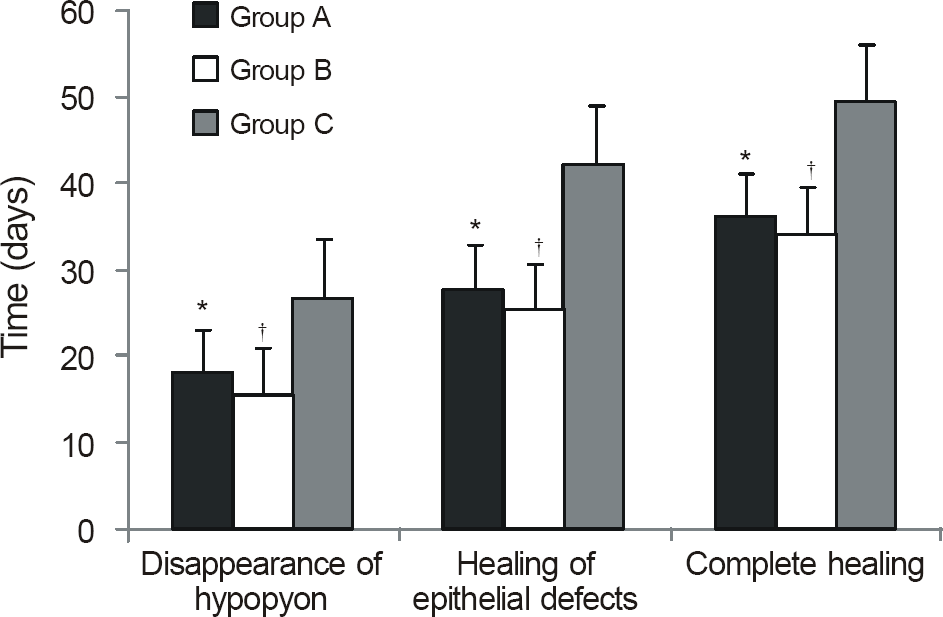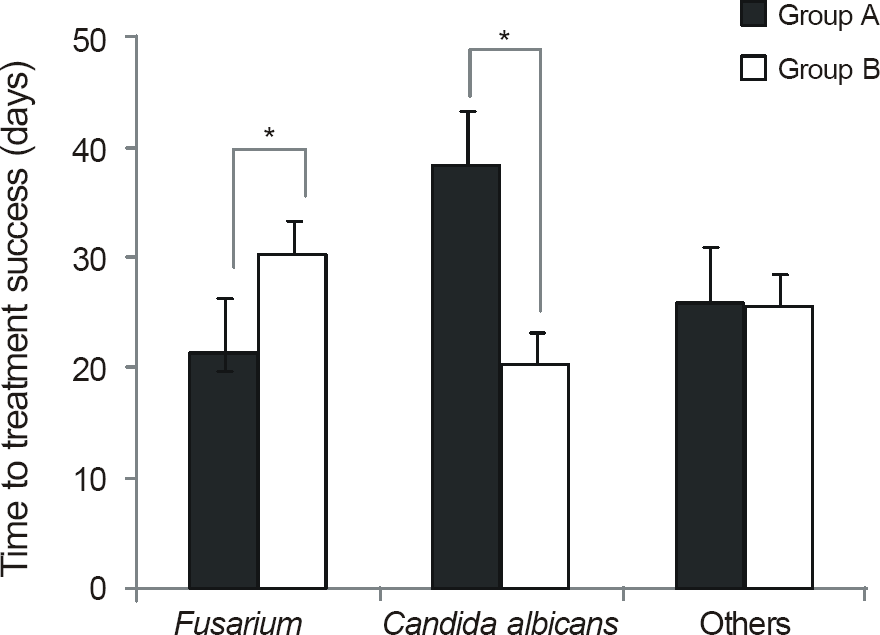Abstract
Purpose
To evaluate clinical effects of intracameral voriconazole injection in fungal keratitis refractory to conventional therapy.
Methods
Thirty-eight eyes of 38 patients with fungal keratitis were included in this study. The patients were divided into 3 groups: 13 patients with intracameral voriconazole injection (50 μ g/0.1 ml; group A), 11 patients with intracameral ampho-tericin B injection (10 μ g/0.1 ml; group B), and 14 patients with conventional therapy only (group C). Clinical factors includ-ing treatment success rate and time to successful treatment were evaluated.
Results
Treatment success was accomplished in 12 eyes in group A (92.3%), 10 eyes in group B (90.9%), and 12 eyes in group C (85.7%). Time to treatment success in group A, B, and C was 36.1 ± 10.4 days ( p = 0.04), 34.2 ± 7.8 days ( p = 0.03), and 49.5 ± 16.7 days, respectively. Patients who had received intracameral voriconazole injection or amphotericin B showed faster fungal keratitis improvement than patients who received conventional treatment. Time to re-epithelialization and time to disappearance of hypopyon showed a similar clinical course.
Go to : 
References
2. Sharma S, Srinivasan M, Upadhyay MP. Corneal blindness: a glob-al perspective. Bull World Health Organ. 2001; 79:214–21.
3. Oh DH, Kim JC, Chun YS. A case of Fusarium deep keratitis fol-lowing scleral graft. J Korean Ophthalmol Soc. 2010; 51:606–10.

5. Kim YS, Song YS, Kim JC. Fungal keratitis caused by chromomycetes. J Korean Ophthalmol Soc. 2003; 44:755–9.
6. Prajna NV, John RK, Nirmalan PK, et al. A randomised clinical tri-al comparing 2% econazole and 5% natamycin for the treatment of fungal keratitis. Br J Ophthalmol. 2003; 87:1235–7.

7. O'Day DM, Head WS, Robinson RD, Clanton JA. Corneal penetration of topical amphotericin B and natamycin. Curr Eye Res. 1986; 5:877–82.
8. Hariprasad SM, Mieler WF, Lin TK, et al. Voriconazole in the treatment of fungal eye infections: a review of current literature. Br J Ophthalmol. 2008; 92:871–8.

9. Shen YC, Wang CY, Tsai HY, Lee HN. Intracameral voriconazole injection in the treatment of fungal endophthalmitis resulting from keratitis. Am J Ophthalmol. 2010; 149:916–21.

10. Yoon JU, Kim SW, Ha BJ, et al. A case of fungal keratitis treated with voriconazole. J Korean Ophthalmol Soc. 2008; 49:1680–4.

11. Kim KH, Kim MJ, Tchah H. Management of fungal ocular in-fection with topical and intracameral voriconazole. J Korean Ophthalmol Soc. 2008; 49:1054–60.

12. Deng SX, Kamal KM, Hollander DA. The use of voriconazole in the management of post-penetrating keratoplasty Paecilomyces keratitis. J Ocul Pharmacol Ther. 2009; 175–7.

13. Yoon KC, Jeong IY, Im SK, et al. Therapeutic effect of intracameral amphotericin B injection in the treatment of fungal keratitis. Cornea. 2007; 26:814–8.

14. Yilmaz S, Ture M, Maden A. Efficacy of intracameral amphoter-icin B injection in the management of refractory keratomycosis and endophthalmitis. Cornea. 2007; 26:398–402.

15. Aydin S, Ertugrul B, Gultekin B, et al. Treatment of two post-operative endophthalmitis cases due to Aspergillus flavus and Scopulariopsis spp. with local and systemic antifungal therapy. BMC Infect Dis. 2007; 7:87.

16. Ghannoum MA, Kuhn DM. Voriconazole -- better chances for pa-tients with invasive mycoses. Eur J Med Res. 2002; 7:242–56.
17. Sabo JA, Abdel-Rahman SM. Voriconazole: A new triazole antifungal. Ann Pharmacother. 2000; 34:1032–43.

18. Loh AR, Hong K, Lee S, et al. Practice patterns in the management of fungal corneal ulcers. Cornea. 2009; 28:856–9.

19. Lee SJ, Lee JJ, Kim SD. Topical and oral voriconazole in the treat-ment of fungal keratitis. Korean J Ophthalmol. 2009; 23:46–8.

20. Reis A, Sundmacher R, Tintelnot K, et al. Successful treatment of ocular invasive mould infection (fusariosis) with the new anti-fungal voriconazole. Br J Ophthalmol. 2000; 84:932–3.
21. Sen P, Gopal L, Sen PR. Intravitreal voriconazole for drug-resistant fungal endophthalmitis: case series. Retina. 2006; 26:935–9.
22. Scott IU, Cruz-Villegas V, Flynn HW Jr, Miller D. Delayed-onset, bleb-associated endophthalmitis caused by Lecythophora mutabilis. Am J Ophthalmol. 2004; 137:583–5.

23. Tu EY, McCartney DL, Beatty EF, et al. Successful treatment of re-sistant ocular fusariosis with posaconazole. Am J Ophthalmol. 2007; 143:222–7.
24. Vemulakonda GA, Hariprasad SM, Mieler WF, et al. Aqueous and vitreous concentrations following topical administration of 1% voriconazole in humans. Arch Ophthalmol. 2008; 126:18–22.

25. Han SB, Shin YJ, Hyon JY, Wee WR. Cytotoxicity of voriconazole on cultured human corneal endothelial cells. Antimicrob Agents Chemother. 2011; 55:4519–23.

26. Gao H, Pennesi M, Shah K, et al. Safety of intravitreal vor-iconazole; electroretinographic and histopathologic studies. Trans Am Ophthalmol Soc. 2003; 101:183–9.
27. Kernt M, Kampik A. Intracameral voriconazole: in vitro safety for human ocular cells. Toxicology. 2009; 258((2-3)):84–93.

28. Shen YC, Wang MY, Wang CY, et al. Pharmacokinetics of intra-cameral voriconazole injection. Antimicrob Agents Chemother. 2009; 53:2156–7.

29. Leck AK, Thomas PA, Hagan M, et al. Aetiology of suppurative corneal ulcers in Ghana and South India, and epidemiology of fun-gal keratitis. Br J Ophthalmol. 2002; 86:1211–5.

30. Bharathi MJ, Ramakrishnan R, Vasu S, et al. Epidemiological char-acteristics and laboratory diagnosis of fungal keratitis: a three-year study. Indian J Ophthalmol. 2003; 51:315–21.
Go to : 
 | Figure 1.Time to disappearance of hypopyon, healing of epi-thelial defects, and complete healing of patients with treatment success in group A, B, and C. * p < 0.05 compared with group A and C. † p < 0.05 compared with group B and C. |
 | Figure 2.Comparison of the time to treatment success between patients given intracameral voriconazole injection (group A) and patients given intracameral amphotericin B injection (group B), according to causative organisms. * p < 0.05 com-pared with group A and B. |
Table 1.
Demographics of patients who were diagnosed with fungal keratitis
Table 2.
Culture results in the groups of patients with fungal keratitis
Table 3.
Treatment success rates and visual prognosis in the groups of patients with fungal keratitis
| Group A (n = 13) | Group B (n = 11) | Group C (n = 14) | p-value† | |
|---|---|---|---|---|
| Treatment success (%) | 12 (92.3) | 10 (90.9) | 12 (85.7) | 0.84 |
| Visual acuity (log MAR) | ||||
| Initial BCVA | 1.98 ± 0.94 | 2.23 ± 0.97 | 1.32 ± 0.17 | 0.13 |
| Final BCVA p-value* | 2.28 ± 0.80 | 2.34 ± 0.69 | 2.13 ± 0.80 | 0.81 |




 PDF
PDF ePub
ePub Citation
Citation Print
Print


 XML Download
XML Download